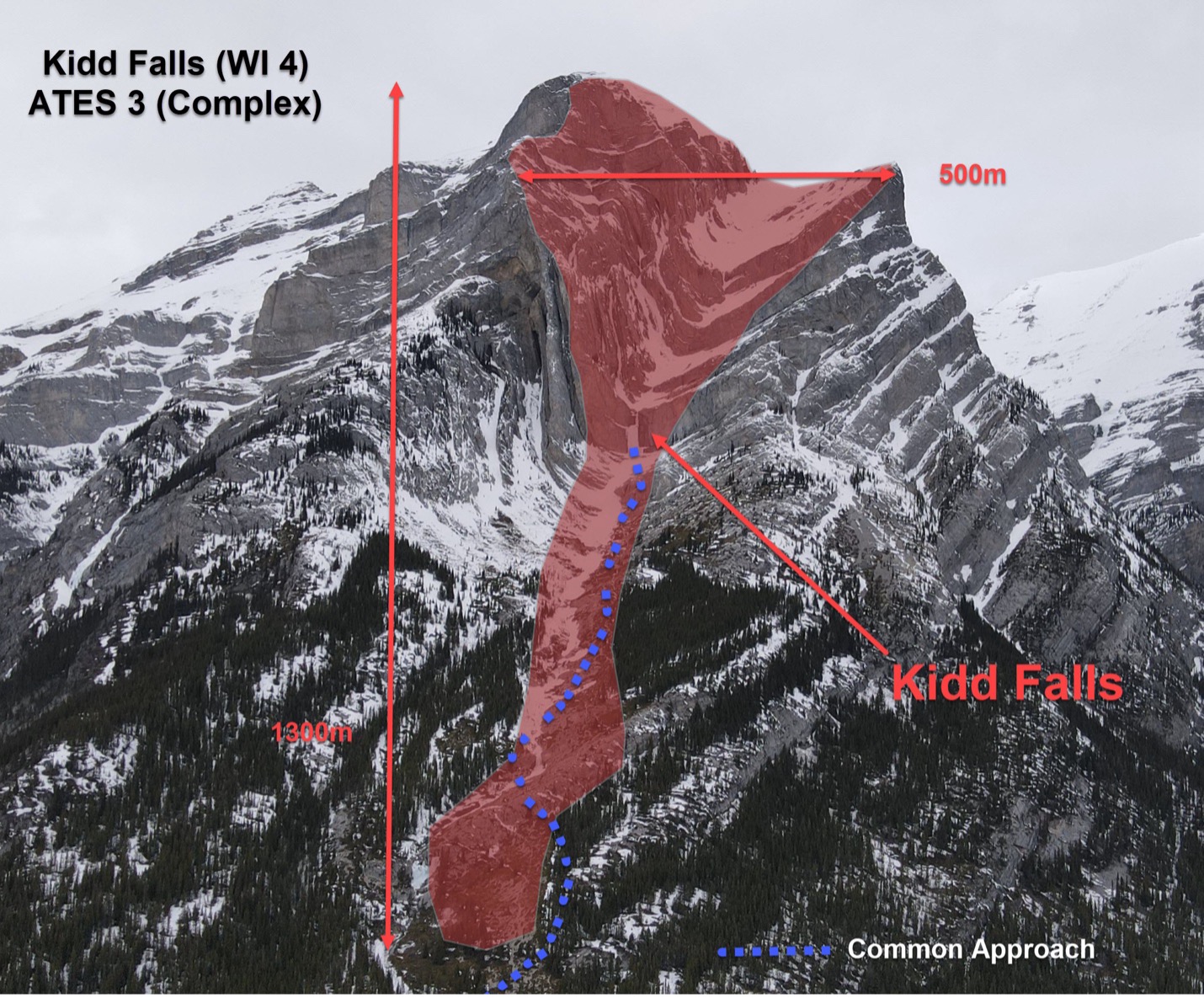
Kidd Falls Climb.
Kidd Falls
55m WI 4
ATES 3 (Complex)
Kidd Falls is a striking two pitch climb in the deep cleft of Mt Kidd. It is easily visible from the road, as well as from Wedge Smears. There is a significant bowl directly above the climb and approach. It is in a large avalanche path and exposure on the approach and top of the route is considerable. This route gets direct sun.
Popularity
- 27 people completed the survey
- 89% climbed it 1-5 times
- 4% climbed it 6-10 times
- 7% climbed it over 10 times
Time of year and day for all Mt Kidd climbs
- The most common time for ascents and witnessing avalanche debris was February- April. December to January was the second most common time and October to November was least common
- 64% of avalanches witnessed occurred between 6:00am-12:00pm
- 43% of avalanches witnessed occurred between 12:00pm-18:00pm
- 7% of avalanches witnessed occurred between 1:00- 6:00am.
Runout debris
- 44% of responses reported seeing debris at the base of the climb
- 27% of responses reported seeing debris in between the pitches of climbing
- 13% of responses reported seeing debris above the last pitch
- 44% of responses reported seeing debris on the walk off
Notes on avalanche debris
- Debris has been reported above the climb in December. Reports state that debris could be up to 1 m deep.
- Debris has also been frequently reported on the climb.
- Debris was witnessed at the bottom of the runout, near the small frozen waterfall near the valley bottom.
- Debris was also reported as frequently running to below the base of the climb, sometimes as far as below treeline.
- Debris was reported as often piling up at the base and can be up to 1 m deep. This was witnessed even in times when the avalanche forecast was favourable.
- In March 2019, a large deposit ran several hundred metres down from the base of the climb. The avalanche was believed to be around a size 3.
- There were multiple reports of large avalanche debris deposits above, on, and under this climb.
Reported avalanches and incidents
- A size 1.5-2 was reported while climbers were on the first pitch. The debris ran over their heads and for 200 m downslope below the climb. The slab was approximately 1-2 m deep. This was a week before the first ascent.
- A large size 1 avalanche was reported as running over the climb and almost burying climbers at the base.
- Approximately 8-10 years ago in late winter, an afternoon avalanche was witnessed coming over Kidd Falls from Wedge Smear.
- An avalanche was observed at Kidd falls 9am after a snowfall, as soon as sun hit the slope. This avalanche was observed from Wedge.
- A belayer was half buried at the base of the ice climb.
- In February 2022, an avalanche was witnessed with a run length of 50-100 m, and a depth of 15-30 cm, which was estimated to be HST. This avalanche was believed to have a solar trigger.
- On December 26th in the late 80's, a group of climbers had finished climb and were at the base of the route when slope above climb released. There had been new snow overnight. The avalanche deposited very little debris, but the powder cloud dusted the area.
- Natural avalanches have been reported, including large avalanches and full path avalanches.
- Avalanches were reported after periods of snow, solar warming, and wind loading.
Contributing factors for all Mt Kidd climbs
- 88% were attributed to new snow amounts
- 40% were attributed to warming and solar radiation
- 24% were attributed to wind
- 10% were attributed to a cornice or human/animal trigger
- 7% were attributed to a known reactive layer
Additional community notes
- Kidd Falls is south facing, meaning it warms up quickly. There are lots of rocks surrounding the climb that can contribute to warming.
- The best times to climb Kidd Falls are on cloudy or very cold days. Warm and sunny days should be avoided unless it is dry overhead. Plan to climb early in the day and be done before the strongest warming